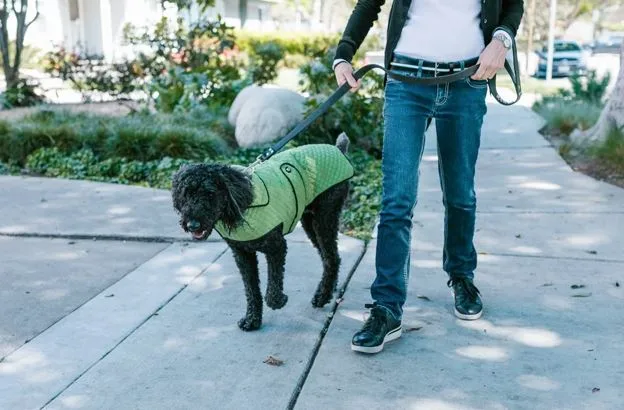Simple Steps for Relaxed Dog Walks (Even if Your Pup Pulls the Leash)
Walking with your dog is quite a pleasant part of your day. You get outside, spend time together, let them sniff around, and see what is happening in the neighborhood. But when your dog drags you down the block every single time, it stops being fun real fast.
And most dog owners have been teaching their dog to pull on the leash. Not on purpose, obviously. But every time your dog lunges forward and you follow along, you’re provoking dog pulling problems. Do this over and over, and it becomes the only way your dog knows how to walk.
Amanda VanTassel, a Certified Dog Trainer (ABCDT) who owns No Hassle Dog Training and contributed expert advice to the PawChamp app’s Journal, has worked with hundreds of dogs who drag their owners down the street. Here, we present some recommendations for relaxed dog walks.
Why Dogs Pull on the Leash?
Between 2021 and 2022, researcher L. Townsend and her team studied leash behavior in pet dogs throughout the UK and Ireland. They found that 82.7% of dogs pull on the leash. That’s more than eight out of ten dogs.
So what makes dogs pull?
- Speed difference. Dogs cover ground faster than humans. The leash tightens because your pace bores them.
- Smell is their whole world. A dog’s nose picks up so many details: that spot on the sidewalk or the base of a tree tells them who was there, when, and what they were doing. Your dog needs to investigate right this second.
- You taught them it works. Every daily dog walking routine where your dog pulled and eventually got to the good stuff was a training session. The lesson was clear: strain forward and good things happen. You didn’t plan to teach this, but your dog learned it anyway.
- Too wound up to listen. Some dogs hit the sidewalk and lose their minds. All the smells, sounds, and movement flood their system. There’s no room left for self-control or checking in with you.
How to Walk a Dog Calmly?
Most dog leash training guides skip this part: you can’t fix leash pulling during the walk itself. Your dog’s already overstimulated, you’re already frustrated, and neither of you is in a learning state.
Start improving dog walking habits inside
How to stop leash pulling? Amanda VanTassel, in her article on relaxed dog walking, advises starting with dog walking training at home. Sounds boring, but this is how dogs actually learn. Attach the leash and walk around your furniture. The second your dog walks next to you without tension on the leash, mark it with a marker word like “yes” and give them a treat. Do this for five minutes, then repeat tomorrow.
Move to calm outdoor training for dogs
After a week of indoor practice, take it outside, but not on your regular route. Find the quietest spot you can: an empty parking lot works, or a quiet side street.
Here are some dog walking techniques for beginners:
- Begin at a comfortable pace and watch.
- When the leash hangs in a gentle curve, pause and pay at your thigh so your dog learns that loose equals good.
- If the leash tightens, simply stop and hold steady without popping or scolding, and wait for the moment your dog softens or glances back.
- Mark that beat, reward, and then float forward for a few more steps, repeating the same calm rhythm.
This is positive reinforcement dog training at its most basic. You’re rewarding the opposite behavior so heavily that pulling stops making sense to your dog.
Address the energy first
Some dogs pull because they’re bursting with energy they haven’t burned off. A tired dog has an easier time focusing. Before you work on leash training, run your dog in the yard. Play fetch until they’re panting, let them sniff around the backyard for ten minutes, then bring out the leash.
This is especially true for young dogs and high-energy breeds. You can’t practice dog training for calm behavior when their body needs to move. Get the physical energy out first, then focus on developing your mental skills.
Make peace with sniff time
Stress-free dog walking means accepting that your dog needs to smell things. A lot of things. Their brain requires this input the way yours requires checking your phone. Build sniff breaks into your walks deliberately. Walk nicely for two minutes, then release your dog to a specific spot and let them investigate for thirty seconds. Use a release word like “go sniff” so they know the difference between working mode and free time.
Use dog training apps
They make your routine much easier with easy sessions you can do at home or on walks. For example, PawChamp covers gentle leash handling techniques, reactivity, barking, and separation anxiety, plus basics, tricks, impulse control, and enrichment games. If you can’t cope with something, there is the opportunity to use the built-in “Ask a Dog Expert” feature to get professional guidance anytime.
Dog Walking Mistakes
The walk is always teaching your dog something. Make sure it’s teaching them what you actually want.
- Letting them pull
You’re tired one day and just let your dog drag you to the park. Or you’re in a hurry and figure one walk where they pull won’t matter. But your dog doesn’t understand “just this once”. They learn that pulling works often enough to keep trying. Leash training for adult dogs falls apart fastest when the rules change based on your mood or schedule.
- Starting walks when they’re amped up
Big mistake. You just rewarded all that chaos by giving them exactly what they wanted in that state. A relaxed walking routine for dogs starts before you touch the leash. Make your dog sit calmly first. If they can’t settle, wait. Put the leash down and ignore them until they stop losing their mind.
- Dogs walk faster than humans naturally
When you try to keep up with their pace, you’re teaching them that speeding ahead is correct. A relaxed pace walking means you set the tempo. Walk at a speed that feels comfortable to you.
- Skipping the sniffing
Some owners think obedience training while walking means their dog should ignore everything and walk perfectly the entire time. That’s not realistic and not fair. Dogs process their world through smell. Forcing them to ignore every interesting scent makes walks stressful.
- Talking too much
Words lose meaning when you use too many. Dog behavior correction methods need one marker word for good behavior. Use it once when your dog does the right thing, and tay quiet the rest of the time. Dogs read your body language and the leash tension better than they listen to a constant stream of commands.
How to Enjoy Walking Your Dog?
Every walk teaches your dog something, whether you plan it or not. The point is, your dog is not a robot that ignores the world. You want a dog that stays near you, handles normal distractions, and doesn’t yank your shoulder out. That’s realistic, but be ready for consistency while training your dog to stay calm outside.





